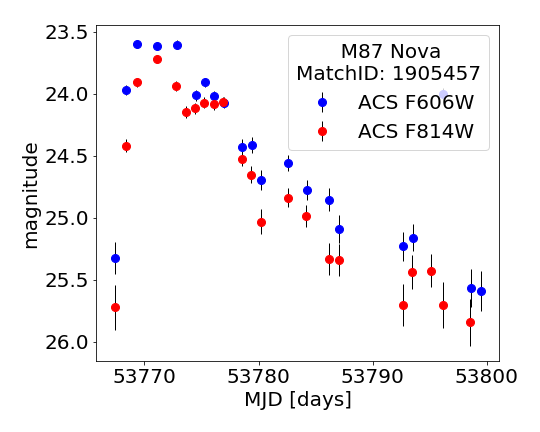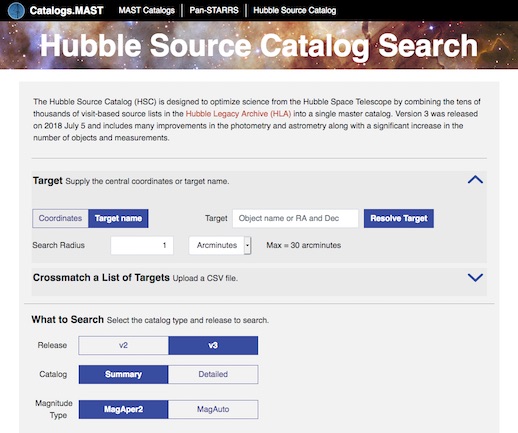|
|||||||||||||||||||
|
|
|||||||||||||||||||
|
|
This is a description of the current version of the Hubble Source
Catalog.
You may still access
HSC version 2 and the
documentation for HSC version 1.
Version 3.1 of the
Hubble Source Catalog
The Hubble Source Catalog (HSC) is designed to optimize science from the Hubble Space Telescope by combining the tens of thousands of visit-based source lists in the Hubble Legacy Archive (HLA) into a single master catalog.
Recent Updates
-
 2019 September 24:
The Hubble Catalog of Variables (HCV),
a major new High-Level Science Product derived from the HSC, was released.
The HCV is the first homogeneous catalog of variable sources found in the HSC.
It includes variable stars in our Galaxy and nearby galaxies, as
well as transients and variable active galactic nuclei. The HCV
contains 84,428 candidate variable sources (out of 3.7 million HSC
sources that were searched for variability) with V <= 27 mag; for
11,115 of them the variability is detected in more than one filter.
The number of data points in a light curve range from 5 to 120, and the
time baseline ranges from under a day to over 15 years.
The released data includes both variable objects and objects identified as
"constant".
2019 September 24:
The Hubble Catalog of Variables (HCV),
a major new High-Level Science Product derived from the HSC, was released.
The HCV is the first homogeneous catalog of variable sources found in the HSC.
It includes variable stars in our Galaxy and nearby galaxies, as
well as transients and variable active galactic nuclei. The HCV
contains 84,428 candidate variable sources (out of 3.7 million HSC
sources that were searched for variability) with V <= 27 mag; for
11,115 of them the variability is detected in more than one filter.
The number of data points in a light curve range from 5 to 120, and the
time baseline ranges from under a day to over 15 years.
The released data includes both variable objects and objects identified as
"constant".
The HCV was created from HSCv3 in a 4 year ESA-funded project at the National Observatory of Athens (PI: Alceste Bonanos). It is available for download via the HLSP page and is also fully integrated with the MAST user interfaces for the HSC, including the HSC CasJobs and VO TAP database query interfaces and the MAST catalogs simple form interface and query API. There are Python Jupyter notebooks available that show how to access the data in scripts. The ESAC Science Data Centre has created the HCV Explorer, a new online web tool to access, visualize, and interactively explore the HCV.
Note that the HCV includes improved magnitudes with local corrections for objects that were searched for variability (those with at least 5 epochs available in some HST filter), so this data may also be useful for projects that are not primarily focused on variability. See the HCV journal paper (Bonanos et al., 2019, A&A, 630, A92) for more details on the project. -
 2019 August 15:
A new search interface for the HSC was
released as part of the MAST catalogs access tools. This interface allows
searching multiple tables and releases of the HSC in a single web form.
Searches can optionally be filtered by catalog parameters (such as magnitudes
and available filters). An API can be used for scripted queries of the catalogs,
and Python Jupyter notebooks show some examples
demonstrating the use of the API for simple and complex queries.
2019 August 15:
A new search interface for the HSC was
released as part of the MAST catalogs access tools. This interface allows
searching multiple tables and releases of the HSC in a single web form.
Searches can optionally be filtered by catalog parameters (such as magnitudes
and available filters). An API can be used for scripted queries of the catalogs,
and Python Jupyter notebooks show some examples
demonstrating the use of the API for simple and complex queries.
- 2019 June 26: HSC version 3.1 was released. It adds to the current HSC version 3.0 by providing proper motions of over 400,000 objects in the augmented Sagittarius Window Eclipsing Extrasolar Planet Search (SWEEPS) HST field. This field is within a few degrees of the Galactic center, and most of the stars belong to the Galactic bulge. The field has been observed by ACS and WFC3 with a time baseline as long as 12 years. The proper motion information is available in the form of database tables within the HSCv3 context of the STScI CasJobs interface. The data can be readily queried by means of SQL through that interface. In addition, we provide a Python Jupyter notebook that runs on Python 3.6. The notebook provides statistical information about the photometry and proper motions and includes some science use cases. More details are found here.
- 2018 July 5: HSC version 3 was released. It includes many improvements in the photometry and astrometry along with a significant increase in the number of objects and measurements.
Highlights from Version 3
- 25% more ACS/WFC images and more than twice as many WFC3 images compared with the HSC v2 release. ACS and WFC3 data that were public as of 2017 October 1 are included. See notes on the HLA DR10 data release and on the current HLA holdings for details.
- Improved photometric quality in the source lists due both to the alignment algorithm used to match exposures and filters in the HLA image processing and to improved algorithms for Source Extractor photometry (particularly near the edges of images).
- Improved astrometric calibration based on the Gaia DR1 catalog.
- The scatter in magnitudes is measured using the median absolute deviation (MAD) of the differences from the median magnitude. This is more robust and less sensitive to outliers than the RMS used in previous versions.
- Cross-matching between HSC sources and spectroscopic COS, STIS, FOS, and GHRS observations.
Properties of the HSC
The HSC v3 contains members of the WFPC2, ACS/WFC, WFC3/UVIS and WFC3/IR Source Extractor source lists from HLA version DR10 (data release 10). The cross-matching process involves adjusting the relative astrometry of overlapping images so as to minimize positional offsets between closely aligned sources in different images. After correction, the astrometric residuals of cross-matched sources are significantly reduced, with median errors less than 8 mas. The absolute astrometry is calibrated using Gaia DR1, Pan-STARRS, SDSS, and 2MASS as the astrometric backbone for initial corrections. In addition, the catalog includes source nondetections. The cross-matching algorithms and the properties of the initial (Beta 0.1) catalog are described in Budavari & Lubow (2012), and the Version 1 catalog is described in Whitmore et al. (2016).
Interfaces
There are currently four ways to access the HSC as described below.
- The MAST Discovery Portal provides a one-stop web access to a wide variety of astronomical data. Select "Hubble Source Catalog v3" in the Select Collection dropdown menu, enter your search target, click Search, and you are on your way. Please try the Use Case Using the Discovery Portal to Query the HSC.
- The HSC CasJobs interface permits you to run large and complex queries, expressed in the Structured Query Language (SQL). Note that it is not difficult to run CasJobs queries from Python script. See the Python Jupyter notebook developed for HSC v3.1 and the Hubble Catalog of Variables notebook for examples.
- The HSC TAP service provides database query access to the HSC through the Virtual Observatory Table Access Protocol (TAP). It is described in more detail in an article in the May 2018 MAST Newsletter. If interested in accessing the older HSC Version 2 via TAP, you may do so using this TAP service.
- The MAST catalogs interface provides a simple but powerful search interface for the HSC and other catalogs (including Pan-STARRS). It includes a user interface for searches at a sky position with optional filtering by catalog parameters and customization of the columns. It also incorporates an API for scripted queries of the catalogs.
- The new HSC search interface has a single web form that allows searching different tables chosen from either the v3 or v2 releases of the HSC catalog. This single page replaces four different web forms from the older HSC search interface.
- Select the HSC Summary Table to display a single row entry for each object, as defined by a set of detections that have been cross-matched and hence are believed to be a single object. Median values for magnitudes, positions, and other relevant parameters are provided.
- Select the HSC Detailed Table to display an entry for each separate detection (or nondetection if nothing is found at that position) using all the relevant Hubble observations for a given object (i.e., different filters, detectors, separate visits).
- See our Python Jupyter notebook for some simple examples that show how to use the HSC API services. Another simple Python notebook generates a color-magnitude diagram of the Small Magellanic Cloud with 750,000 objects in only a couple of minutes. A more advanced notebook demonstrates the ability to perform large queries that return 500,000 rows of data from the SWEEPS proper motion data. There is also an Hubble Catalog of Variables notebook that shows how to find variable objects and show their light curves and images.
Five things you should know about the HSC
1. Detailed Use Cases and Videos are available.
2. Sky coverage can be very non-uniform (unlike surveys such as SDSS) due to the highly variable HST observing patterns.
3. Current WFPC2, ACS/WFC and WFC3 source lists are of variable quality. In particular, the WFPC2 source lists are of poorer quality than the ACS and WFC3 source lists.
4. The default is to show all HSC objects. This may include a large number of artifacts. You can request NumImages > 1 (or more) to filter out many artifacts.
5. The default is to use mag_aper2 Source Extractor values for magnitudes (in the ABMAG system) . You can request mag_auto if desired.
Current Limitations
- About 30% of the ACS/WFC, WFC3, and WFPC2 images are not included in the catalog due to image quality and other issues (e.g., moving targets, grism observations, cosmic ray contamination, etc.)
- About 6% of the source lists (white-light images) in the HSC do not have an astrometric correction from either an external catalog (e.g. Gaia) or from overlapping HST images. (Note this is much improved from the previous version.)
- About 19% of the sources could not be cross-matched with sources in other visits. Such single sources are nonetheless included in the catalog.
Help and Acknowledgment
More detailed information can be found on the Frequently Asked Questions page. Several Use Cases are available to give you step by step instructions. There are also videos available.
We are interested in your feedback. If you have questions, or items to bring to our attention, please send them to: archive help.
HSC Data Use Policy:
The HSC is based on data from the Hubble Legacy Archive (HLA).
Refereed publications making use of the HSC should therefore include this footnote in the acknowledgements:
Based on observations made with the NASA/ESA Hubble Space Telescope, and obtained from the Hubble Legacy Archive, which is a collaboration between the Space Telescope Science Institute (STScI/NASA), the Space Telescope European Coordinating Facility (ST-ECF/ESAC/ESA) and the Canadian Astronomy Data Centre (CADC/NRC/CSA).
Authors are also asked to acknowledge the "Hubble Source Catalog" in the text of the paper, and consider a reference to the Whitmore et al.(2016) paper describing the HSC.
|
|
|




 Follow Us
Follow Us